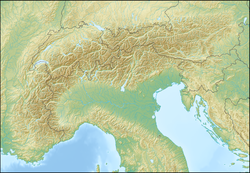1117 Verona earthquake
 | |
| Local date | 3 January 1117 |
|---|---|
| Epicenter | 45°30′N 11°00′E / 45.500°N 11.000°ECoordinates: 45°30′N 11°00′E / 45.500°N 11.000°E |
| Max. intensity | VII (Very strong) |
An earthquake, rated at VII (Very strong) on the Mercalli intensity scale, struck northern Italy and Germany on 3 January 1117.[1] The epicentre of the first shock was near Verona, the city which suffered the most damage. The outer wall of the Arena di Verona was partially felled, and the standing portion was damaged in a later earthquake of 1183. Many other churches, monasteries, and ancient monuments were destroyed or seriously damaged, eliminating much of Verona's early medieval architecture and providing space for a massive Romanesque rebuilding.[2] After the first shock of 3 January, seismic activity persisted for months, striking on 12 January 4 June, 1 July 1 October, and 30 December.
The earthquake was not only felt in Verona but across northern Italy, from Cividale to Pavia, south to Pisa and north to Switzerland.[3] Outside of Verona the most damaged areas were Milan, Bergamo, Brescia, Venice, Treviso, Modena, Parma, and Cremona. The main churches of Padua all suffered major damage. News of the earthquake reached Montecassino and Reims.[4] The Milanese chronicler Landolfo Iuniore reported that the church synods needed to be carried out in the open air, due to the destruction. In Germany, damage was also extensive. The in Bamberg, the abbey at Brauweiler, and buildings in Rottenburg am Neckar, Constance, Meersburg, and Fénis were all reported damaged.[5]
Recent studies, however, suggest that it was not a major, single event on 3 January, but instead a series of shocks in the areas of Verona (west Veneto) and Cremona (Lower Lombardy), which happened in a few days or even in a few hours. Other earthquakes may have hit as far south as Pisa (northwest Tuscany) and as north as Augsburg (southwest Bavaria), as distinct events, in the same days.[6]
See also[]
Notes[]
- ^ Banca Ipermediale delle Vetrate Italiane, Archived 19 July 2011 at the Wayback Machine Consiglio Nazionale delle Ricerche
- ^ G. Solinas (1981), Storia di Verona (Verona: Centro Rinascita), 244. The late eight- or early ninth-century Versus de Verona contains a now indispensable description of Verona's early medieval architecture, including Roman ruins.
- ^ http://www.ips.it/scuola/concorso/terremoti/home4.htm
- ^ Emanuela Guidoboni-Enzo Boschi (1989), "I grandi terremoti medioevali in Italia," Le Scienze, 249.
- ^ Thomas Glade, Malcolm Anderson, Michael J. Crozier (2005), Landslide Hazard and Risk (John Wiley and Sons, ISBN 0-471-48663-9), 261.
- ^ P. Galli, The earthquakes of January 1117 in northern Italy. Hypothesis for an epicentre in the southern Po Plain (Cremona)
Sources
- Guidoboni, E.; Comastri, S.; Boschi, E. (2005), "The "exceptional" earthquake of 3 January 1117 in the Verona area (northern Italy): A critical time review and detection of two lost earthquakes (lower Germany and Tuscany)", Journal of Geophysical Research, 110 (B12309), Bibcode:2005JGRB..11012309G, doi:10.1029/2005JB003683
External links[]
- Page on the 1117 Verona earthquake from the CFTI5 Catalogue of Strong Earthquakes in Italy (461 BC – 1997) and Mediterranean Area (760 B.C. – 1500) Guidoboni E., Ferrari G., Mariotti D., Comastri A., Tarabusi G., Sgattoni G., Valensise G. (2018) (in Italian)
- 12th-century earthquakes
- Earthquakes in Italy
- 1117 in Europe
- 12th century in Italy
- 1110s in the Holy Roman Empire
- History of Verona
